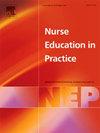探索转变:影响澳大利亚二级护士进入护理学士学位课程的决定因素
IF 3.3
3区 医学
Q1 NURSING
引用次数: 0
摘要
目的本研究旨在揭示预测从二级护士到注册护士过渡的相关人口统计学和教育决定因素。从二级管理护士到一级管理护士的过渡是护理职业道路上一个重要的专业和教育里程碑。关于预测哪些学生将尝试这种转变的决定因素的研究很少。设计采用二次资料分析的回顾性队列研究。方法:本研究分析了澳大利亚学生结果调查中包含的2023名护理文凭毕业生的学习后结果。采用加权逻辑回归来估计几个协变量的预测边际。结果我们的研究揭示了几个人口统计学和教育决定因素与本科水平护理课程的入学率有很大的联系。在评估高等教育入学预测因素的重要性时,确定了以下因素,其重要性由高到低依次为:学习原因、学生年龄、获得文凭资格的机构类型、学习地点的偏远程度、以前在卫生部门的经验、土著血统、英语语言状况和性别。结论从二级监管护士到一级监管护士的转变不是随机的,有几个因素促成了这种转变。学者和政策制定者在制定对护理人员有影响的政策时可能会发现这些信息很有用。本文章由计算机程序翻译,如有差异,请以英文原文为准。
Exploring the transition: Determinants influencing Australian second-level nurses’ progression to Bachelor of Nursing programs
Aim
This study aims to reveal the relevant demographic and educational determinants in predicting a transition from being a second level to a Registered Nurse.
Background
The transition from a second to a first-level regulated nurse represents a significant professional and educational milestone in the nursing career pathway. Research on determinants predicting which students will attempt this transition is scant.
Design
Retrospective cohort study using secondary data analysis.
Method
A large cohort of 2023 graduates of the Diploma of Nursing contained in the Australian Student Outcome Survey is analysed in this study with respect to their post-study outcomes. Weighted logistic regression is employed to estimate predictive margins for several covariates.
Results
Our study reveals several demographic and educational determinants that show substantial association with enrolment in bachelor-level nursing courses. In assessing the significance of predictors for enrollment in higher education, the following factors were identified in descending order of importance: reason for study, student age, institution type where the Diploma qualification was obtained, remoteness of study location, prior experience in the health sector, Indigeneity origin, English language status and gender.
Conclusion
The present study demonstrates that the transition from a second-level to a first-level regulated nurse is not random and that several factors contribute to this transition. Academics and policymakers may find this information useful when framing policy that has an impact on the nursing workforce.
求助全文
通过发布文献求助,成功后即可免费获取论文全文。
去求助
来源期刊

Nurse Education in Practice
NURSING-
CiteScore
5.40
自引率
9.40%
发文量
180
审稿时长
51 days
期刊介绍:
Nurse Education in Practice enables lecturers and practitioners to both share and disseminate evidence that demonstrates the actual practice of education as it is experienced in the realities of their respective work environments. It is supportive of new authors and will be at the forefront in publishing individual and collaborative papers that demonstrate the link between education and practice.
 求助内容:
求助内容: 应助结果提醒方式:
应助结果提醒方式:


